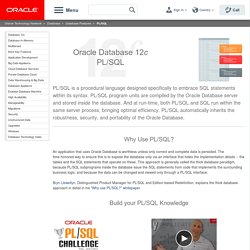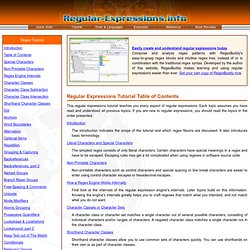

Nls_lang faq. Doing_sql_from_plsql.pdf (application/pdf-Objekt) Why Use PL/SQL?

An application that uses Oracle Database is worthless unless only correct and complete data is persisted. The time-honored way to ensure this is to expose the database only via an interface that hides the implementation details -- the tables and the SQL statements that operate on these. This approach is generally called the thick database paradigm, because PL/SQL subprograms inside the database issue the SQL statements from code that implements the surrounding business logic; and because the data can be changed and viewed only through a PL/SQL interface. Bryn Llewellyn, Distinguished Product Manager for PL/SQL and Edition-based Redefinition, explains the thick database approach in detail in his "Why use PL/SQL?
" whitepaper. Build your PL/SQL Knowledge Join the PL/SQL Challenge community and try out these PL/SQL quizzes, learn as you go. Getting Started With PL/SQL Building and Managing PL/SQL Program Units Error Management An exploration of error management features in PL/SQL. Tabibitosan method tutorial by Aketi. ************************** For exsample3 (collect Rows continued Months) create table Ex3 (DateVal primary key) as select date '2009-09-01' from dual union select date '2009-10-01' from dual union select date '2009-12-01' from dual union select date '2010-01-01' from dual union select date '2010-02-01' from dual union select date '2010-04-01' from dual; select min(DateVal),max(DateVal),count(*) from (select DateVal, extract(year from DateVal)*12 +extract(month from DateVal) -Row_Number() over(order by DateVal) as disTance from Ex3) group by disTance order by min(DateVal); MIN(DATE MAX(DATE COUNT(*) -------- -------- ---------- 09-09-01 09-10-01 2 09-12-01 10-02-01 3 10-04-01 10-04-01 1 ***************************************************************** 3.

What is complex usage of "Tabibitosan method" ? ? :| ************************** For exsample4 (collect Rows continued and ID is equal) from Group by preserving the order. Regular Expressions Tutorial Table of Contents. This regular expressions tutorial teaches you every aspect of regular expressions.

Each topic assumes you have read and understood all previous topics. If you are new to regular expressions, you should read the topics in the order presented. Introduction The introduction indicates the scope of the tutorial and which regex flavors are discussed. It also introduces basic terminology. Literal Characters and Special Characters The simplest regex consists of only literal characters. Non-Printable Characters Non-printable characters such as control characters and special spacing or line break characters are easier to enter using control character escapes or hexadecimal escapes. How a Regex Engine Works Internally First look at the internals of the regular expression engine's internals. Character Classes or Character Sets A character class or character set matches a single character out of several possible characters, consisting of individual characters and/or ranges of characters. The Dot Anchors.